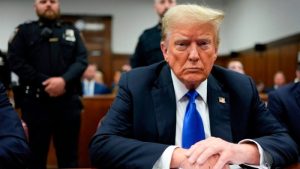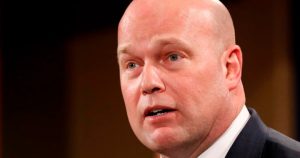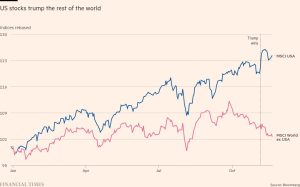Could North Carolina be in play for the Democrats?
This is an on-site version of the US Election Countdown newsletter. You can read the previous edition here. Sign up for free here to get it on Tuesdays and Thursdays. Email us at [email protected]
Good morning and happy Thursday! Today let’s dive into:
-
Democrats’ growing confidence in North Carolina
-
A major union declining to endorse
-
Political implications of the Federal Reserve’s rate cut
At one point in the White House race, North Carolina seemed like the swing state that posed the toughest challenge for the Democrats, but the party is growing more confident that it’s in play for Kamala Harris.
Donald Trump is still up by 1.4 percentage points in the state, according to the FT’s poll tracker, but when I was in Charlotte last week, local Democratic politicians and operatives told me that Harris’s presence at the top of the ticket has reinvigorated support for the party in North Carolina. The state last went blue in 2008, when Barack Obama was first elected president.
To flip the state, Democrats need to heed lessons learnt in the 2022 midterms, especially in the party stronghold of Mecklenburg County, which encompasses Charlotte, North Carolina’s most populous city.
Mecklenburg is the party’s best opportunity to shore up votes since it’s the county with the most Democrats, but it has had low turnout in recent years. “It’s simply untenable if Democrats want to have a real shot at winning the state,” said Drew Kromer, the 27-year-old chair of the Mecklenburg County Democratic Party. Particular attention needs to be paid to Black voters, who make up 55 per cent of registered Democrats in the county, he added.
He said the party “wasn’t particularly active” in the county two years ago, but over the past 16 months Democrats have “built a much more robust party infrastructure”.
“If Mecklenburg can fix its turnout problem, we will become North Carolina’s Fulton County,” Kromer said, referring to the Georgia county incorporating Atlanta, which was pivotal in Biden’s 2020 win.
“It’ll be close, whatever [the result] is, but I think that we’re going to be able to do it,” said state representative Mary Belk, whose district is in Mecklenburg County. “We understand that we’ve got to reach out and talk to [voters] that we haven’t been talking to,” she added, including young people in the fintech sector who are moving to the state.
The most important thing for the party to do in deeply divided North Carolina is make sure people get the message that their vote matters, said state senator Natasha Marcus, who also represents Mecklenburg County. That includes ensuring they are prepared for the first presidential election in which they must present a valid form of identification to vote in North Carolina.
Campaign clips: the latest election headlines
Behind the scenes
The International Brotherhood of Teamsters, an influential US union, said it would not endorse a presidential candidate, a sign that a core part of the Democrat’s voting bloc might be drifting to the right.
The decision not to endorse came after a phone poll of union members — who are heavily concentrated in the swing states of Pennsylvania, Michigan and Wisconsin — showed that 58 per cent wanted the Teamsters to endorse Trump, with 31 per cent preferring Harris.
The move was basically a “tacit endorsement” of Trump, union board member John Palmer told the FT’s Taylor Rogers.
Referencing Trump’s history of animosity with unions, Palmer said:
It was a cowardly political move by people who wanted to pander to the membership instead of taking up what would have been a hit by telling the truth.
Harris has won the endorsement of other big unions, but the Teamsters’ decision comes as Democrats and some labour leaders fear that Trump has made inroads with working-class voters.
This is the first time in almost 30 years that the union hasn’t endorsed a candidate, and it last backed a Republican in 1988.
“Unfortunately, neither major candidate was able to make serious commitments to our union to ensure the interests of working people are always put before Big Business,” union president Sean O’Brien said in a statement.
Datapoint
The Federal Reserve opted for a chunky half-point rate cut yesterday, and signalled that borrowing costs will fall further this year [free to read].
The decision could provide a boost for Harris, who has been campaigning on bringing down everyday costs, a top voter concern.
Trump — who has been critical of Fed chair Jay Powell — said the Fed’s move showed the US economy was either “very bad” or that it was “playing politics”.
“I guess it shows the economy is very bad to cut it by that much, assuming that they are not just playing politics,” he said on Wednesday. “The economy would be very bad, or they are playing politics, one or the other. But it was a big cut.”
It was a milestone for the central bank, marking the first time it has cut rates in more than four years.
The federal funds rate is now between 4.75 per cent and 5 per cent, and officials’ latest dot plot — in which they sketch out their rate forecasts — showed they expect that to fall to 4.25 per cent to 4.5 per cent by the end of the year.
Policymakers are expecting rates to drop by another percentage point next year, and fall just below 3 per cent by the end of 2026.
Viewpoints
Recommended newsletters for you
FT Exclusive — Be the first to see exclusive FT scoops, features, analysis and investigations. Sign up here
Breaking News — Be alerted to the latest stories as soon as they’re published. Sign up here
#North #Carolina #play #Democrats






